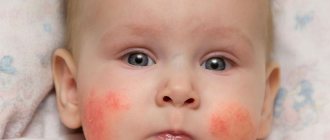Signs of allergies in children
An allergy is a sensitive and painful reaction of the body to a variety of substances.
The disease is almost always genetic in nature; immunity is involved in the formation of the disease. The causes of allergies are very different.
Types of childhood allergies
Parents and doctors most often encounter the following types of allergic reactions:
- For dust (caused by mites, mold, hair particles, pollen, etc.).
- On animals. The child’s immune system reacts not to pet hair, but to skin proteins and animal saliva.
- For food. Any product can be an allergen. But there are also leaders: cow's milk, fish, seafood, eggs, nuts.
- Hay fever (pollen is the allergen).
- Reaction to medications, household chemicals.
Cold, vitamins, and insect bites also sometimes cause allergies.
The most common symptom in children
Allergies are not difficult to detect; it is more important to determine its type, and only a doctor can do this. Parents should take their child to the doctor if they notice the most common allergic symptoms:
- Rash, hives, itchy skin.
- Conjunctivitis.
- Allergic rhinitis.
- Bronchial asthma (in this case, you should contact a doctor immediately so as not to trigger the disease).
- Allergic bronchitis.
- Atypical symptoms include fever due to childhood allergies (food or drug).
Allergies must be treated immediately so that serious consequences do not arise and the disease does not remain with the child for life.
Thus, chronic rhinitis can cause severe headaches, and Quincke's edema can develop (as with conjunctivitis).
The most serious complications of asthma are anaphylactic shock or asphyxia, which develop very quickly and are extremely life-threatening.
The first signs of allergies in children
Allergies have many symptoms of varying severity. But the first signs of allergies in children are easy for parents to recognize:
- Sneezing, runny nose, itchy nose.
- Cough, shortness of breath, whistling when breathing.
- Signs of suffocation.
- Skin irritation in the form of redness, itching, peeling, dryness, blisters, rashes, swelling.
- It burns in the eyes, and increased tearfulness.
- Nausea, vomiting, diarrhea or constipation.
- Intestinal colic.
Age characteristics
Can allergies go away on their own during life or with age? Sometimes it can. But in any case, it is necessary to limit contact with the allergen for quite a long time.
The course of allergic reactions has its own characteristics in different age groups:
- Children under 1 year. The most common manifestations of the disease are atopic dermatitis (also called neonatal diathesis) and food allergies. They have a typical clinical picture in the form of skin lesions. They arise when the baby is introduced to complementary foods, the menu is expanded and they are offered to try foods unfamiliar to their body for the first time. The reason for the occurrence of a pathological reaction on the part of the immune system is its immaturity in infants and the inability to “correctly” react to the entry of unfamiliar substances into the body. After enough time has passed without a relapse, thanks to restrictive measures, the allergy may disappear as the child grows older and reaches adolescence. It is at this moment that the immune system independently adapts and establishes protective mechanisms.
- Children of preschool and teenage age. The most common manifestations of hypersensitivity reactions at this age, along with food allergies, are allergic rhinitis, rhinosinusitis, and conjunctivitis. In the pathogenesis of disease development, it is important that the allergen enters the body not only through the digestive tract, but also through the respiratory (airborne) route. It is important to promptly identify the provoking factor and take the necessary measures to limit contact with the allergen. Such simple steps are often enough to cope with the disease. A child can “outgrow” an allergy by the time of puberty, when the body’s immune system fully develops.
- Adults. Hypersensitivity reactions have more serious manifestations in the form of bronchial asthma, dermatitis, occupational allergies, urticaria, Quincke's edema, and anaphylaxis. Diseases tend to recur and cause so-called cross-reactions, which significantly expand the list of possible allergens. A feature of this age period is the fact that the fully formed immune system of an adult retains a “memory” of the impact of the allergen on the body throughout its entire life. Do allergies go away with age in adults? Such a development is unlikely. Only strict measures to prevent the entry of an irritating factor into the body contribute to the occurrence of long-term clinical remission. The disease worsens again when encountering an allergen, often in a more aggressive form.
According to scientific data, approximately every third adult inhabitant of the globe has manifestations of one or another allergic disease.
How do food allergies manifest?
This allergy is very common and appears first on the skin. Signs of food allergies in children are rash, blisters, hives, itching.
With hives, as with other rashes, the child may scratch the skin very hard (until scars appear). The risk of skin infection and the transition of urticaria to allergic eczema cannot be excluded.
In addition, food allergies may be accompanied by:
- Nausea, vomiting.
- Abdominal pain, diarrhea.
If you experience a skin rash or other symptoms, contact your doctor as soon as possible.
Since the disease is subsequently fraught with serious conditions (anaphylactic shock, bronchospasms and many others). The doctor will find the cause of the allergy, that is, identify the food allergen.
How do allergies occur in infants?
Allergies occur if the child is weaned early or is not breastfed at all (mother’s milk contains many protective substances that enhance the baby’s immunity), when changing formulas, new foods, dysbacteriosis, or using certain medications.
Most often, signs of an allergy in an infant appear on the skin:
- Rashes and itching occur.
- The skin turns red, becomes dry, and peels.
- Crusts may appear on the scalp.
- The baby's stool may change.
The following food allergens most often aggravate reactions: cow's milk, eggs, fish, some cereals, orange or red vegetables or fruits. Ordinary prickly heat does not cause itching, the skin does not peel, and the stool does not change.
How to prevent allergies in young children?
Children in their first year of life are more vulnerable to the disease. Pay close attention to your diet while breastfeeding. Keep a diary and track your baby's reactions in it.
When introducing complementary foods, try to introduce foods that do not cause allergies in babies first. For example, when adding porridge to your diet, start with soaked rice. Rice allergies are very rare. Start complementary feeding at a strictly defined age.
For babies whose allergic reaction manifested itself before complementary feeding, the introduction should be delayed by .5 months. Thermal treatment reduces the allergic characteristics of eggs, fruits and vegetables.
If your baby shows signs of illness, do not despair or panic. Even if your baby is allergic to everything, following the doctor’s advice will help you organize proper nutrition.
In most cases, this is food intolerance, so by the age of three, in 90% of children there is no trace of the disease.
Follow your doctor's orders. Stick to your prescribed diet and stay healthy!
Back to contents
IN
Allergies: children and animals
Signs of an allergy to cats in children (can also be to dogs, hamsters and other domestic animals) appear upon contact with special substances that are contained in the saliva and urine of animals.
The symptoms are easy to confuse with signs of ARVI. For allergies to animals in children:
- The nose is stuffy, there is a strong runny nose, and sneezing.
- The mucous membrane of the eye turns red, lacrimation is more abundant than usual.
- There may be a barking cough, wheezing in the lungs.
- Redness, rash, itching, and swelling may occur on the skin.
Only a doctor can diagnose whether it is an acute respiratory viral infection or an allergy to your beloved cat.
Diagnosis, therapy, prevention
Now in the arsenal of allergists there are many methods for preventing allergies in children and treating them.
Allergist:
- He will examine the child, clarify his dietary habits, the presence of animals in the house and a number of other factors that can cause allergies.
- Next, skin tests for allergies or blood tests are prescribed.
- After diagnosis, the allergist will name the type of allergen and prescribe the necessary treatment. As a rule, antihistamines of the so-called second generation are prescribed. They are good because they have much fewer contraindications than the drugs of the previous generation.
As preventive measures, doctors call:
- Continue breastfeeding for a long time.
- Minimizing allergenic foods in the child’s menu (everything in moderation).
- The need to keep bookshelves and cabinets closed.
- Frequent wet cleaning, use of a humidifier.
- Reduce contact with pets.
- Washing clothes with anti-allergenic products.
- Clothes and bedding for a child should be purchased from anti-allergenic materials.
Children with allergies may well “outgrow” the disease during puberty. But control is also necessary later.
The most important thing that parents should remember:
- There are certain symptoms that indicate allergic reactions in a child.
- An allergy signals a “problem” in the body: it thus asks for protection from the allergen.
- Self-medication is unacceptable
- Timely diagnosis of the disease by a doctor will be the key to curing allergies and preventing its relapses. It is always better to be on the safe side than to take a child with a severe illness to a specialist.
- The doctor will determine the allergen and prescribe the optimal treatment.
- Preventive measures will help prevent an allergic reaction in children.
See you in new articles!
Can allergies go away with age?
The answer is ambiguous. After all, it all depends on the type of allergy, hereditary factors, and the age of the child.
“Allergies to milk, eggs, and soy products are most often outgrown by children,” says Dr. Neeta Ogden, an allergy specialist in New Jersey and a spokeswoman for the American College of Allergy, Asthma and Immunology (ACAAI). "But even for some allergies that tend to be lifelong, including peanut allergies, there is some evidence that your little one may outgrow them."
In fact, a 2013 study published in the American Journal of Asthma and Clinical Immunology found that more than a quarter of children had outgrown their allergies by the time they were 5 and a half years old.
Let's look at the likelihood of whether your baby will outgrow allergies by type of allergen.
Dairy
Sensitivity to cow's milk is the most common allergy, affecting 2% of children under 4 years of age. Luckily, this is also something that people usually outgrow—about 64% of children are free of their milk allergy by the time they reach 12 years of age. You can try reintroducing milk and dairy products every few months to see if your baby's body can handle it. Some children have no problem with baked goods (such as cake) that have milk as an ingredient, even if they cannot handle a glass of milk without allergic reactions.











